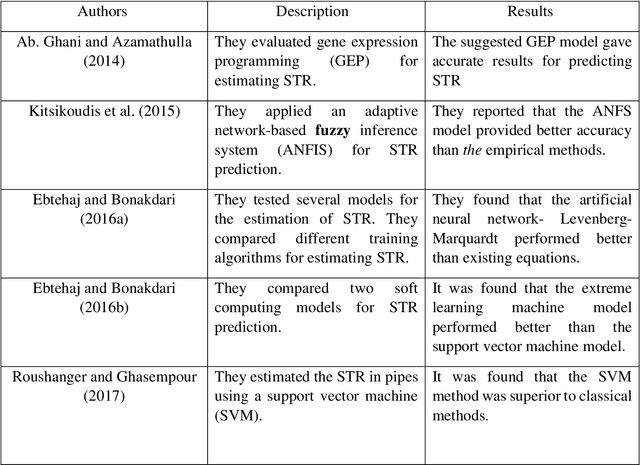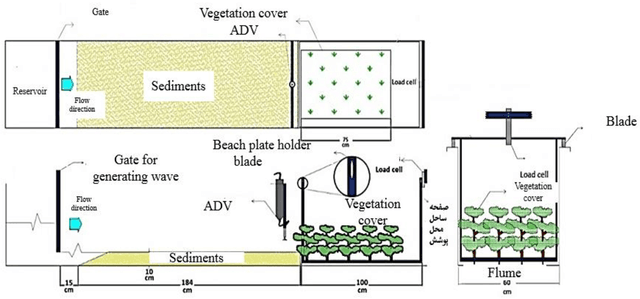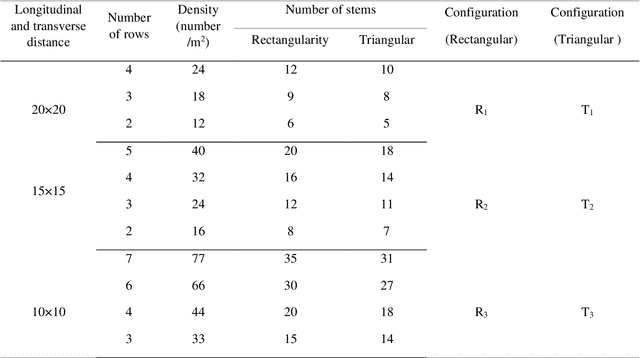Mohammad Ehteram
Application of Group Method of Data Handling and New Optimization Algorithms for Predicting Sediment Transport Rate under Vegetation Cover
Sep 16, 2022



Abstract:Planting vegetation is one of the practical solutions for reducing sediment transfer rates. Increasing vegetation cover decreases environmental pollution and sediment transport rate (STR). Since sediments and vegetation interact complexly, predicting sediment transport rates is challenging. This study aims to predict sediment transport rate under vegetation cover using new and optimized versions of the group method of data handling (GMDH). Additionally, this study introduces a new ensemble model for predicting sediment transport rates. Model inputs include wave height, wave velocity, density cover, wave force, D50, the height of vegetation cover, and cover stem diameter. A standalone GMDH model and optimized GMDH models, including GMDH honey badger algorithm (HBA) GMDH rat swarm algorithm (RSOA)vGMDH sine cosine algorithm (SCA), and GMDH particle swarm optimization (GMDH-PSO), were used to predict sediment transport rates. As the next step, the outputs of standalone and optimized GMDH were used to construct an ensemble model. The MAE of the ensemble model was 0.145 m3/s, while the MAEs of GMDH-HBA, GMDH-RSOA, GMDH-SCA, GMDH-PSOA, and GMDH in the testing level were 0.176 m3/s, 0.312 m3/s, 0.367 m3/s, 0.498 m3/s, and 0.612 m3/s, respectively. The Nash Sutcliffe coefficient (NSE) of ensemble model, GMDH-HBA, GMDH-RSOA, GMDH-SCA, GMDH-PSOA, and GHMDH were 0.95 0.93, 0.89, 0.86, 0.82, and 0.76, respectively. Additionally, this study demonstrated that vegetation cover decreased sediment transport rate by 90 percent. The results indicated that the ensemble and GMDH-HBA models could accurately predict sediment transport rates. Based on the results of this study, sediment transport rate can be monitored using the IMM and GMDH-HBA. These results are useful for managing and planning water resources in large basins.
Modeling and Uncertainty Analysis of Groundwater Level Using Six Evolutionary Optimization Algorithms Hybridized with ANFIS, SVM, and ANN
Jun 28, 2020



Abstract:In the present study, six meta-heuristic schemes are hybridized with artificial neural network (ANN), adaptive neuro-fuzzy interface system (ANFIS), and support vector machine (SVM), to predict monthly groundwater level (GWL), evaluate uncertainty analysis of predictions and spatial variation analysis. The six schemes, including grasshopper optimization algorithm (GOA), cat swarm optimization (CSO), weed algorithm (WA), genetic algorithm (GA), krill algorithm (KA), and particle swarm optimization (PSO), were used to hybridize for improving the performance of ANN, SVM, and ANFIS models. Groundwater level (GWL) data of Ardebil plain (Iran) for a period of 144 months were selected to evaluate the hybrid models. The pre-processing technique of principal component analysis (PCA) was applied to reduce input combinations from monthly time series up to 12-month prediction intervals. The results showed that the ANFIS-GOA was superior to the other hybrid models for predicting GWL in the first piezometer and third piezometer in the testing stage. The performance of hybrid models with optimization algorithms was far better than that of classical ANN, ANFIS, and SVM models without hybridization. The percent of improvements in the ANFIS-GOA versus standalone ANFIS in piezometer 10 were 14.4%, 3%, 17.8%, and 181% for RMSE, MAE, NSE, and PBIAS in the training stage and 40.7%, 55%, 25%, and 132% in testing stage, respectively. The improvements for piezometer 6 in train step were 15%, 4%, 13%, and 208% and in the test step were 33%, 44.6%, 16.3%, and 173%, respectively, that clearly confirm the superiority of developed hybridization schemes in GWL modeling. Uncertainty analysis showed that ANFIS-GOA and SVM had, respectively, the best and worst performances among other models. In general, GOA enhanced the accuracy of the ANFIS, ANN, and SVM models.
* 42 pages, 11 figures
 Add to Chrome
Add to Chrome Add to Firefox
Add to Firefox Add to Edge
Add to Edge